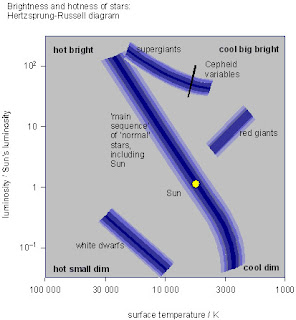That simple description raises a number of questions. If you are interested in exploring these issues further click on the "Read the rest of the post" link.
1. How do astronomers determine the luminosity of a star from its spectrum?
The first step is to determine the surface temperature. This can be done from the spectrum. A simplified version of a spectrum for a star like the sun is displayed below.

Note the colors range from dark blue to dark red. There are dark lines in the spectrum. Each line is caused by the absorption of light at that particular frequency by an element in the star's atmosphere. The electrons in the atoms of the elements have to be at particular energy levels to absorb the light. The energy levels of atoms are determined by temperature, so the temperature of the star can be determined.

The next step is to use a Hertzsprung - Russell diagram (illustrated at right) to determine the luminosity of the star. The horizontal axis is the surface temperature and the vertical axis is the star's luminosity as a ratio of the luminosity of the sun. The calibration of the diagram has been improved by the large number of stars that have been studied by the Hipparcos satelite.
Most stars are on the "main sequence" so to determine the luminosity from star temperature take a line up from the appropriate location on the horizontal axis to the main sequence and then read off the luminosity from the vertical axis.
2. How is distance determined from absolute luminosity?
We can use the formula:
D = 10(m-M+5)/5
where D = distance, m = apparent magnitude and M = absolute magnitude.
Magnitude measure is an issue that I will not discuss in this post.
I will use Spica as an example:
Apparent magnitude: m = 0.98
Spectral type is B1
From HR diagram this indicates an absolute magnitude, M, in the range: -3.2 to -5.0
For M = -3.2, D = 10(0.98 - (-3.2) + 5) / 5 = 68.54 parsecs (pc)
For M = -5.0, D = 10(0.98 - (-5.0) + 5) /5
The Hipparcos measurements give D = 80.38 .
Spectroscopic Parallax provides a distance measurement to stars but is not particularly accurate.
No comments:
Post a Comment